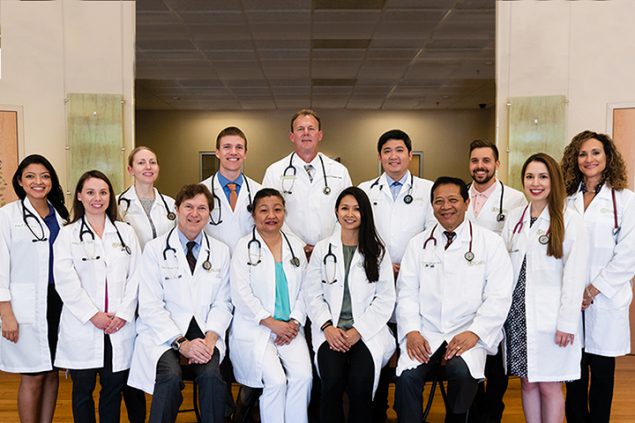Success Story: Two Coordinated Health Care Teams Improve Medication Adherence
Sharp Rees-Stealy Medical Group (San Diego) and Southwest Orlando Family Medicine (Orlando)
In previous rounds of the Hypertension Control Challenge, Million Hearts® established a benchmark of 70% hypertension control for applicants’ adult populations. This 2017 success story reflects the earlier benchmark.
The Opportunity
When it comes to managing high blood pressure, many health care professionals know that medication adherence—taking medicines as directed—can be a major hurdle on the way to success. But two health care teams discovered ways to inspire patients to take their blood pressure medicines on time and in the right amount while improving overall care in the process.
Sharp Rees-Stealy Medical Group, founded in 1923, is one of the oldest medical groups in San Diego, California. It serves more than 330,000 people in San Diego County and is part of the Sharp HealthCare system, which operates seven hospitals and 22 clinics. Southwest Orlando Family Medicine (SWOFM), operating regionally for 28 years, is an independently owned family practice that serves nearly 20,000 people at two locations in Orlando, Florida.
Though they operate on vastly different scales on opposite sides of the country, both care groups learned that they could succeed in patient blood pressure control with creative, team-based approaches that focus on patients not just as numbers or targets but as people with complex motivations and needs.
What They Did
To achieve better patient blood pressure control, the two medical groups took similar key steps.

“Remember to listen to the patient, because they’re trying to tell you a story. It’s not just about ‘This is a new pill you need to get to that target.’ It’s about understanding why the patients aren’t doing what you’re saying.”
—Bryan Roy, MSN, ARNP, FNP-BC, chief operating officer, Southwest Orlando Family Medicine
Established a chronic care management team
Both groups began by organizing their administrative processes, including aligning team members around common goals, adopting simplified treatment and medication guidelines, and establishing and analyzing patient registries to show clinicians which patients were not taking their medicines.
Sharp Rees-Stealy has a dedicated population health department that collaborates with physicians, nurse practitioners, medical assistants, health coaches, pharmacists, and other staff to adopt and tailor best practices for controlling patient hypertension. That process has included adopting a standardized hypertension protocol and evidence-based practices for heart attack and stroke prevention and sharing learning among peers from other organizations.
SWOFM has a dedicated analyst to evaluate and report data such as medication adherence and blood pressure control. These efforts increased awareness and helped shape new models of patient care. For example, data showed that patients with uncontrolled high blood pressure had fewer regular office visits. This led to the birth of SWOFM’s chronic care management team, a collaborative of doctors, nurses, medical assistants, coaches, and others who share responsibility for working with patients on medication adherence and other preventive care goals.
“If you’re not looking at the data, you just assume you’re doing good, because you feel good about each patient that you deal with,” said Bryan Roy, MSN, ARNP, FNP-BC, chief operating officer of SWOFM. “But when you aggregate that information at a registry level, it starts to tell a different story.” In 2017, SWOFM reached a hypertension control rate of nearly 83%.

“Medication adherence is truly a partnership between the patient and the clinical team.”
—Parag Agnihotri, MD, medical director, population health and post-acute care, Sharp Rees-Stealy Medical Group
Focused on the patient
SWOFM encourages patients to bring their pill bottles to each office visit. This gives the care team insights into whether the patient is taking the medicine as directed. Via annual or biannual patient surveys, SWOFM also uses a special adherence risk estimator to determine whether someone is not likely to adhere, based on whether the patient values the treatment plan. This survey allows the team to learn answers to more unique, subjective questions that often don’t come up during office visits.
Sharp Rees-Stealy also regularly assesses patients to find out what medicines they take, whether they are adhering (and if not, why not), and their goals for success. This step is crucial to understanding why a patient is not adherent and allows the care team to try different approaches to improving adherence. For example, if the patient is not taking the medicine because of side effects, the physician or pharmacist can work with the patient to find a different medicine or work with a health coach to incorporate lifestyle changes that enhance other treatments. Sharp Rees-Stealy also uses multiple ways of reaching out to patients to support medication adherence, including text messaging and home blood pressure monitoring programs. In 2017, the group reached a hypertension control rate of 82%.
“Medication adherence is truly a partnership between the patient and the clinical team,” said Parag Agnihotri, MD, population health and post-acute care medical director for Sharp Rees-Stealy. “It means helping each other to understand the values and the socioeconomic impacts related to managing high blood pressure.” Dr. Agnihotri also stressed the importance of making patient and staff education an ongoing part of the hypertension control process.
Advice for Others
For other health care practices and systems that want to improve patients’ medication adherence and overall hypertension, Sharp Rees-Stealy and SWOFM have a few tips:
- Make sure everyone on the care management team understands and supports the program’s goals and guidelines.
- Reach a consensus about what you want to achieve. Set clear, measurable targets.
- Have a diverse care team, including health coaches, medical assistants, and other support staff. This helps prevent physician fatigue. It also helps patients feel more connected, supported, and involved in managing their own care.
- Educate your care team and patients on the seriousness of hypertension and the consequences of not taking needed medicines.
- Invest in data analytics and population health outreach.
